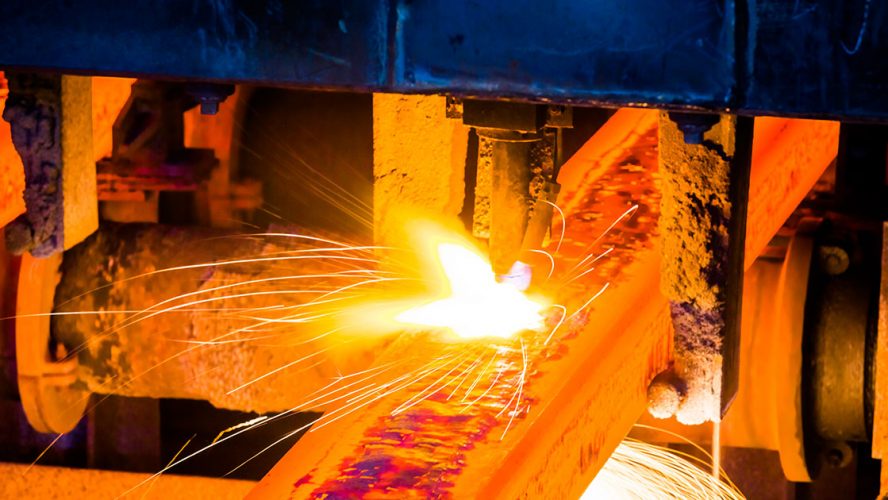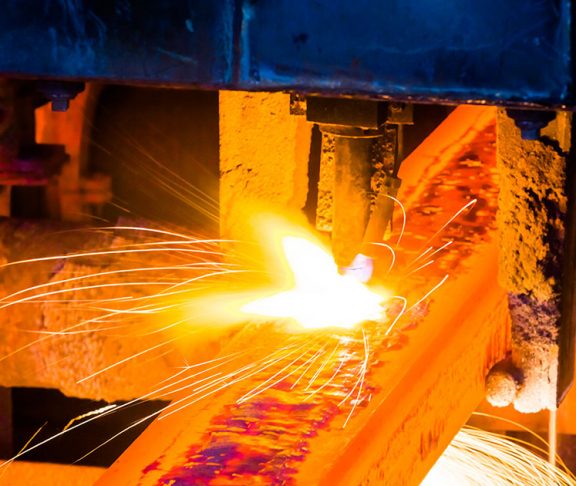Today’s American steel industry is high-tech, environmentally conscious and highly efficient. But in this age of digitalization and cloud computing, steel still starts from the ground up — under the ground, to be exact.
The birth of steel
Steelmaking begins with the raw materials: coal, limestone and iron ore. Once mined, each requires further processing.
Ironmaking is the process of converting iron ore into liquid iron. First, coal is baked in ovens to produce pure carbon called “metallurgical coke,” a necessary fuel for blast furnaces. Next, limestone is added to improve chemical reactions and absorb impurities from the molten iron. 98 percent of all mined iron ore is used in the steel production process.
The blast furnace uses coke, iron ore and limestone to produce liquid iron — the fundamental element of steel.
Modern improvements
While this process has been around for centuries, modern operations use computer models, robotics, remotely operated machinery and artificial intelligence to monitor and manage conditions inside the furnace. Gone are the days when workers stood within feet of molten metal to manually check conditions with handheld tools.
The manpower needed to produce a ton of steel has been dramatically reduced due to new technologies, innovative labor agreements and simple economies of scale. Fewer but larger furnaces mean fewer workers on the shop floor and safer operations.
According to the Steel Manufacturers Association (SMA), productivity is five times what it was in 1980. Back then, 10 man-hours were required to produce one ton of steel. Today that number is 1.9 man-hours, which represents the average for both the blast furnace and electric furnace production methods.
The SMA’s president, Philip Bell, reports that the most efficient electric furnace operations (known as mini-mills) produce steel at less than half a man-hour per ton. In the U.S., the number of electric arc furnaces (EAFs) greatly outweighs the number of blast furnaces — 68% vs. 32% (globally, it’s the reverse). As with blast furnaces, improved casting technologies and intelligent manufacturing systems have helped mini-mills become more efficient.
EAF and DRI
In the EAF, electrical energy is used to melt recycled steel scrap via electrical arcs to create liquid steel. EAFs are known for their smaller carbon footprint and higher efficiency. Several steelmakers have taken the mini-mill concept a step further in terms of product range, scale of operation and electricity consumption. One method to improve product range by changing the raw material is the use of direct reduced iron (DRI) pellets or briquettes.
“The use of DRI has provided an iron ore–based metallic that has extended the range of products that could be produced in electric arc furnaces. These materials, with their excellent chemistry, dilute the residual elements normally present in the scrap supply,” said Dr. Joseph Poveromo, a steel industry consultant with RMI Global Consulting.
In the centuries-long history of steelmaking, DRI is relatively new to the scene. But in the last 10 to 15 years, it has evolved dramatically in terms of quality and metallization (the amount of iron oxide that has been converted to metal). And DRI is versatile; any steelmaker can use it, but it is primarily consumed by EAFs.
DRI is produced in a low-pressure reactor by the direct reduction of iron ore, reducing the oxygen content of the ore without melting it. Natural gas — or other gases, such as hydrogen — is used as the reducing agent to produce DRI.
The use of natural gas is more environmentally friendly than coke-based blast furnaces. It’s safer, too, as the lower processing temperature means the product never reaches a molten state. The steam is purer than coal steam, which leads to purer DRI. And with shale gas exploration booming in recent years, natural gas is now more abundant and less expensive. This makes DRI more economically feasible.
Automation and safety
Advances in process control allow for the prediction of product quality via sensors. With the use of closed-loop systems to automatically adjust to changes, this is a great leap forward in efficient and improved quality control.
There have been great leaps forward in other aspects of steelmaking — the making of iron is just the beginning. And while the basic steps of the iron- and steelmaking process are the same as they were 100 years ago, the implementation of new technologies has vastly improved the process, making it easier, safer and faster.
“The whole steelmaking process has become much more highly automated,” says Jeremy Jones of CIX Inc., a steel industry consultancy.
“We’ve automated more things, and we’re trying to measure more things and analyze more things, but we still need operators to make decisions. They’re just shifted away from the vicinity of the furnace; they’re in a safer work environment.”

